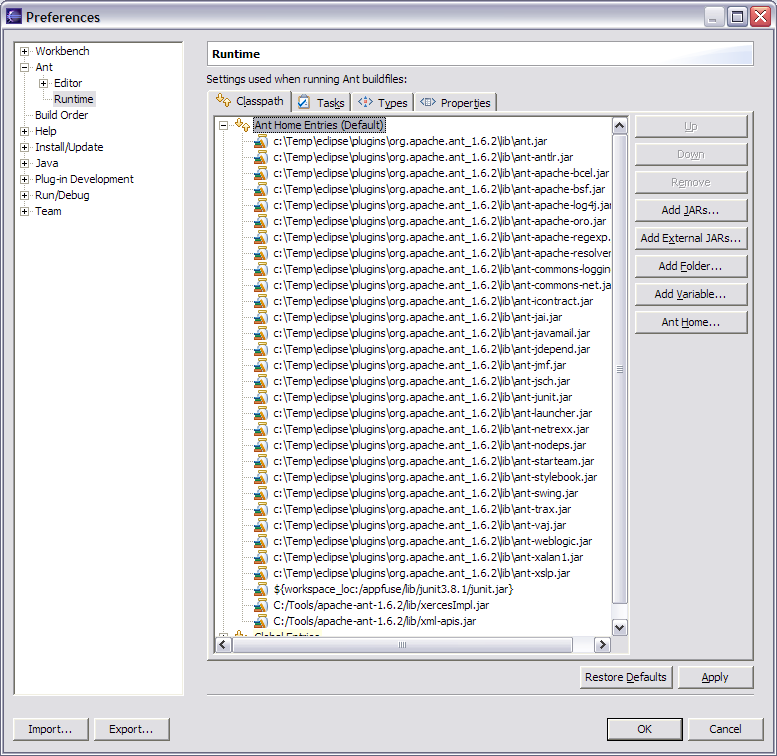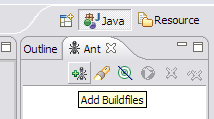Appfuse1.9,JDK1.5,ANT1.6.2,Mysql5.0,Tomcat5.5
šłÄ.ÁéĮŚĘÉŤģĄ°ĹģŚQ?br />šĽ•šłčÁéĮŚĘÉŚŹėťáŹŚĚáśĆČśú¨śúļÁöĄŚģČŤ£ÖŤĶ\ŚĺĄŤģĺĺ|ģŚć≥ŚŹĮ„Ä?br />ANT_HOME,
JAVA_HOME,
CATALINA_HOME,
MYSQL_HOME
Pathšł≠Śä†ŚÖ?br />%JAVA_HOME%bin;%ANT_HOME%bin;%CATALINA_HOME%bin;%MYSQL_HOME%bin;
šļ?Śú®eclipsešł≠šč…ÁĒ®antĺ~ĖŤĮĎŚQĆŚŹĎŚłÉÔľĆčĻčŤĮēappfuse
1.Create New Java Project in Eclipse
Open Eclipse (either with an existing or a new workspace) and to go File ‚Ü?New ‚Ü?Project. Then select "Java Project" and hit the Next button. In the Project Name field, enter the name of your project (i.e. appfuse) and the directory that your project lives (i.e. c:\source\appfuse) in the box below. If you're prompted to switch the Java Perspective, choose Yes.
If you try to build the project at this point, you'll likely get numerous errors. Most of them involve the fact that the UserForm class can not be found. This is because all of the ActionForms in AppFuse (if you're using the Struts version) are generated from POJOs with XDoclet.
All of the tasks for XDoclet are configured in the Ant build.xml file so the easiest thing to do is to run "ant gen-forms" to generate the ActionForms. If you have Ant 1.6.2+ installed and in your path, you can do this from the command line. The next step shows you how configure Eclipse to run your AppFuse build.xml.
2.Configuring Ant in Eclipse
The easiest way to configure Eclipse for AppFuse is to install Ant on your hard drive (i.e. c:\Tools\apache-ant-1.6.2) and then point Eclipse's ANT_HOME to this directory. To do this, go to Window ‚Ü?Preferences ‚Ü?Ant ‚Ü?Runtime. Then click the "Ant Home" button and select the installation folder on your hard drive.
If you'd rather use Eclipse's built-in Ant, you'll need to add junit.jar to its classpath. To do this, go to Window ‚Ü?Preferences ‚Ü?Ant ‚Ü?Runtime. Then click the "Add JARs" button and select junit.jar from appfuse/lib/junit3.8.1/lib/junit.jar. Click OK until you arrive back at the workbench view.
Next, add the catalina-ant.jar (from $CATALINA_HOME/server/lib) to the ant classpath. Then in the property tab, add tomcatTasks.properties (in lib/ant-contrib) file as a global properties file.
Below is a screenshot of what your Ant Runtime classpath should look like after the above modifications:
3.Add build.xml to Ant View
Now we need to add the build.xml to Eclipse's Ant View. To do this, go to Window ‚Ü?Show View ‚Ü?Ant. Then click on the first icon in this view (screenshot below) to add AppFuse's build file.
4.Run Ant
After adding the build.xml, you should be able to expand it in the Ant View and execute any of the targets. I usually do "test-all" to verify all the tests pass in my initial project. For a list of targets I use most often, see AppFuse Ant Targets.
Now if you run the "compile" target and then refresh the project (right-click on project ‚Ü?Refresh) you shouldn't see any errors in the "Problems" pane. You should now be able to compile and create classes as you normally would. Sometimes when my imports aren't resolving correctly in Eclipse, I do have to run Project ‚Ü?Clean in Eclipse.
NOTE: If you're using the internal version of Ant, you may get an error message like the one below:
BUILD FAILED: C:\source\appfuse\build.xml:802: The following error occurred while executing this line:
C:\source\appfuse\build.xml:780: The following error occurred while executing this line:
java.lang.NoClassDefFoundError: org/apache/xml/serialize/OutputFormat
This is because there are tasks that require Xerces to be in your Ant classpath [reference]. I added xercesImpl.jar and xml-apis.jar (from my self-installed version of Ant) to Eclipse's Ant classpath to solve this.
5.Run JUnit Tests in Eclipse
It's also possible to run your JUnit tests in Eclipse. But before running them, you need to run the "war" target. After this target completes, refresh your project.
After you have successfully done so, in Eclipse open a test you'd like to run (i.e. UserDaoTest) and go to Run ‚Ü?Debug As ‚Ü?JUnit Test. Note that you may have to run the "db-load" target before you run your tests every so often. I did have the following method in the Base*TestCase class for each layer, but this caused DBUnit to reload the database before every test in a Test class. Removing it reduces the execution time of "test-all" by more than 30 seconds.
 
    protected void setUp() throws Exception {
        DataSource ds = (DataSource) ctx.getBean("dataSource");
        IDatabaseConnection conn = new DatabaseConnection(ds.getConnection());
        IDataSet dataSet =
            new XmlDataSet(new FileInputStream("metadata/sql/sample-data.xml"));
        // clear table and insert only sample data
        DatabaseOperation.CLEAN_INSERT.execute(conn, dataSet);
        conn.close();
    } 
If the instructions above don't work for running JUnit tests in Eclipse, I suggest just using the command line - i.e. ant test-dao -Dtestcase=UserDAO. Running tests from the command line always works. ;-)
Ś•ĹšļÜ ŚQĆŚú®eclipsešł≠Śüļśú¨śĆČšĽ•šłäśďćšĹúěģĪŚŹĮšĽ•śąźŚäüšļÜŚQĆÁ≠ČśúČśó∂ťóŖ_ľĆśąĎśĚ•ĺėĽŤĮĎšłÄšłčԾƍôĹÁĄ∂śąĎÁöĄeśĖáśĮĒŤĺÉÁÉāŚQĆšĹÜśėĮŤŅėśėĮšĻźšļéŤģ©Ś§ßŚģ∂ś†°ś≠£Áö?br />ŚQöԾȌéüśĖáÁöĄŚúįŚĚÄŚQ?a >http://raibledesigns.com/wiki/Wiki.jsp?page=AppFuseEclipse
ťóģťĘėśŹŹŤŅį
1.ŚąöŚľÄŚßčÁöĄśó∂ŚÄôԾƜąĎšĽ¨ÁöĄmysqlÁöĄÁĒ®śą∑ŚźćŚíĆŚĮÜÁ†ĀŚŹĮŤÉĹŚíĆappfuseÁöĄťĽėŤģ§ÁöĄÁĒ®śą∑ŚíĆŚĮÜÁ†ĀšľöšłćšłÄś†ÔLöĄŚQĆŤŅôšł™ŚŹĮšĽ•Śąįproperties.xmlśĖášögšł≠šŅģśĒĻšōϚĽ¨ŚģČŤ£ÖmysqlśėĮŤģĺĺ|ģÁöĄÁĒ®śą∑ŚźćŚíĆŚĮÜÁ†ĀŚQĆśąĎÁöĄšŅģśĒĻŚ¶āšłčÔľö
 <!-- Defaults for database.properties -->
    <property name="database.jar" location="${mysql.jar}"/>
    <property name="database.type" value="mysql"/>
    <property name="database.name" value="appfuse"/>
    <property name="database.host" value="localhost"/>
    <property name="database.username" value="root"/>
    <property name="database.password" value="780121"/>
   
    <!-- database URL for creating other dbs - used in db-create target -->
    <property name="database.admin.url" value="jdbc:${database.type}://${database.host}/mysql"/>
    <property name="database.admin.username" value="root"/>
    <property name="database.admin.password" value="780121"/>
    <property name="hibernate.dialect" value="org.hibernate.dialect.MySQLInnoDBDialect"/>
    <property name="database.driver_class" value="com.mysql.jdbc.Driver"/>
    <property name="database.url"
        value="jdbc:${database.type}://${database.host}/${database.name}?useUnicode=true&amp;characterEncoding=utf-8"/>
    <property name="database.show_sql" value="true"/>
śąĎśėĮšŅģśĒĻšļÜrootÁĒ®śą∑ÁöĄŚĮÜÁ†ĀԾƌĹďÁĄ∂šĹ†šĻüŚŹĮšĽ•ŚĽļÁęčtestÁĒ®śą∑Úq∂ÁĽôŚąĚŚßčŚĮÜÁ†ĀŚQöÔľČ
2.ėqěśé•śēįśćģŚļďÁöĄťóģťĘėŤß£ŚÜ≥ŚźéԾƌŹ¶Ś§ĖšłÄšł™ťóģťĘėśúČŚáļśĚ•šļÜԾƌĽļÁęčuser_roleŤ°®ÁöĄśó∂ŚÄôŚáļťóģťĘėšļÜÔľöorg.dbunit.dataset.NoSuchTableException: user_role
ėqôšł™ťóģťĘėÁöĄŤß£ŚÜŌxĖĻŚľŹŚ¶āšłčÔľö
setup-tomcat deploy
ant setup -Ddatabase.username=foo -Ddatabase.password=bar
ėqôšł™šłĽŤ¶ĀśėĮŚÖąśČߍ°ĆšĽ•šłčbuild.xmlšł≠ÁöĄsetup-tomcate deployśĆáš◊oěģĪŚŹĮšĽ•šļÜŚQöÔľČ
ŚéüŤĚ≤ŚúįŚĚÄŚQ?a >http://b0r0j0.blogbus.com/logs/2005/12/1725103.html